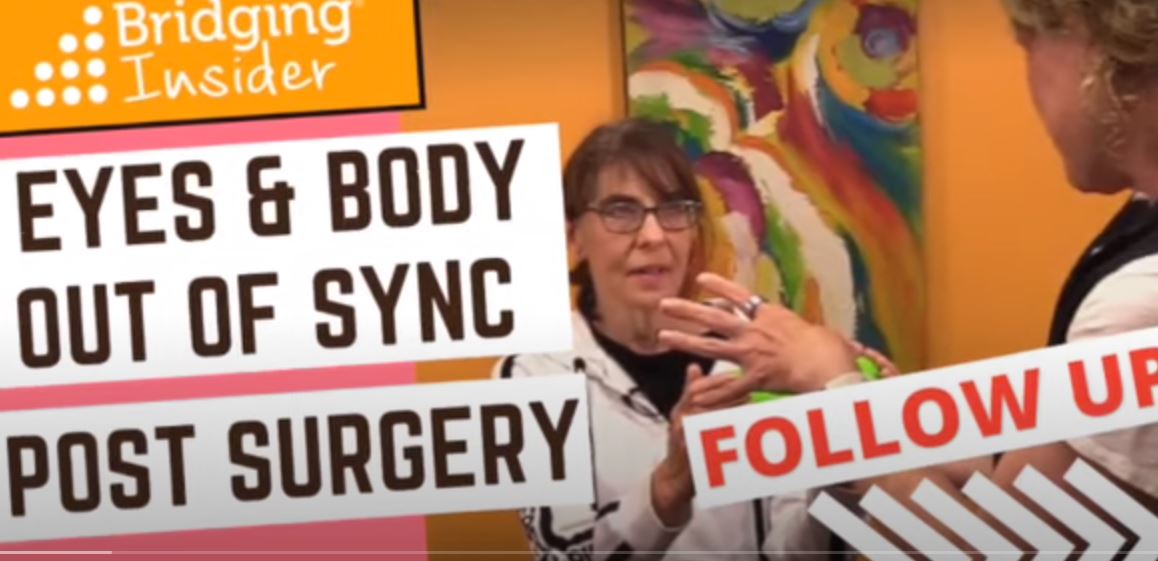Vision and Hand-eye Coordination Problem-solving
The theme for this week … being active can also involve hands, arms and eyes!
Many activities have a visual-motor component which incorporates use of our hands and arms in conjunction with vision. Sometimes the parts could be working together better than we assume they are. Read on …
We assume our vision and hands/arms work together. But do they really?
Being good at ball sports, racquet sports, fishing, bowling, etc. all require that our vision is well-integrated with the way our arms and hands move.
In the Bridging® problem-solving process used with all of our clients regardless of age, we uniquely look at how movement of the hands, arms, head, and eyes are working together in a coordinated way.
To better understand the context of what we are looking at, it is helpful to understand how and when the integration of hand function and vision originally develops. (Often referenced as hand-eye coordination.)
Early development of visual-motor skills
An infant’s brain and motor skills are busy developing in their early months. By about age 6-9 months, the two converge as babies are grasping and reaching for everything! This article from the American Academy of Ophthalmology outlines early visual-motor development stages.
We assume that by a certain age our vision and hands/arms automatically work together without really thinking that maybe they don’t. This assumption turns out to be false for many people.
We often find clients, especially children, whose arms, head, and eyes work well as individual systems, but get mixed up when putting it all together. Sometimes it’s because of an accident, but sometimes these systems are still waiting for their chance to learn to integrate.
In the featured video with Sarena, you will see her visual-motor fluency is inhibited by the arm and shoulder function from a prior auto accident.
Insight of the week from Cara
Figuring out the weak links in the visual-motor system
Bear with me … my engineering background is talking today.
When your motor system and visual system don’t link up, we methodically look at other systems in the body to see where transitions and symmetry are missing. Supporting and resetting these usually lead to better visual function and integration.
Root cause failure analysis
The problem solving process we use in Bridging® is referred to as “root cause failure analysis” in the engineering world.
Root cause failure analysis is a systematic review of a system, step by step, and piece by piece. Usually a failure occurs at a transition point because these are areas of stress.
Bridging® problem-solving
Once upon a time, I applied the same thought process to the body and movement. Guess what? It turns out that movement transitions often glitch, and the locations of the glitch are the source of your pain or coordination issues.
This is the heart of the Bridging® problem-solving process. We systematically test movement ability and transitions. We also check how the guidance system of vision works with motor transitions. It matters!
Have you had visual stress or trouble with motor skills, and are you curious if we can help?
Stories from our sessions … Resetting motor skills to work better with vision
What happened to Sarena?
Micromovement disrupters
What’s happened to Sarena and when?
- Birth/Early life: Forceps delivery, hip dysplasia, had leg braces for a period of time
- Injury/Accident: Rear-end auto accident (age 45)
- Medical procedures/surgeries: surgery (age 57)
- Illness: digestive (age 29)
Sorting out the events that impacted visual-motor ease
Goal: Reduce daily stress and recover her ease of visual skills in order to be more active.
In the featured video session, we check back in with Sarena a month later after working with her to improve the way her overall movement supported visual tracking ease. She has some improvement, yet can tell the need for more.
As you will see, the Bridging® process takes into account a more realistic intersection of how vision and the body work together. This includes:
- Unique assessment which is very different than a vision professional uses. The asymmetry of how her arms and core work together is impacting her ability to integrate arm movement with visual skills.
- Unique consideration of how the body supports the visual function. We take the approach that the body is limiting the visual skill. Generally the visual skill improves as the body function improves.
By the end of the Bridging® session, symmetry has returned to Sarena’s upper body movement, and the visual-motor function has much more fluency.
This is a really interesting Bridging® application, and I’m grateful to Sarena for being willing to share with you.

